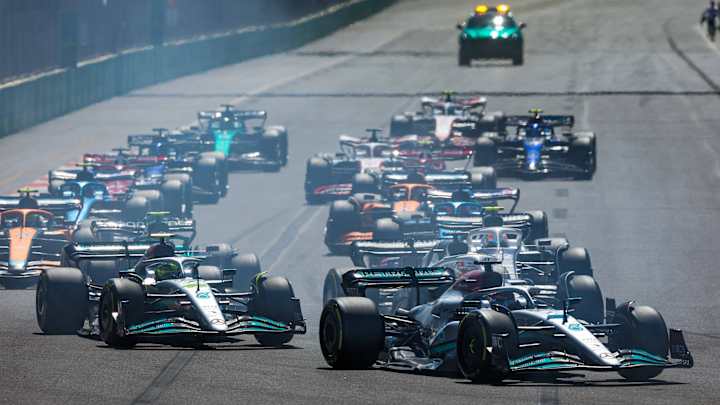F1’s Governing Body Takes Steps to ‘Intervene’ on Porpoising

The FIA has issued a technical directive to the Formula One teams after drivers raised safety and health concerns in regards to the porpoising they have felt this season, especially in Baku.
Up until this past weekend, it was primarily just George Russell and Carlos Sainz vocalizing the concerns. However, the bouncing reached a new level on the Azerbaijan Grand Prix’s street circuit.
The FIA acted swiftly, finding it “necessary to intervene to require that the teams make the necessary adjustments to reduce or to eliminate this phenomenon.” The steps the governing body intends to take are as follows, per the announcement.
“1. Closer scrutiny of the planks and skids, both in terms of their design and the observed wear
2. The definition of a metric, based on the car’s vertical acceleration, that will give a quantitative limit for acceptable level of vertical oscillations. The exact mathematical formula for this metric is still being analysed by the FIA, and the Formula 1 teams have been invited to contribute to this process.”
Although these are short-term measures, the FIA says it will also hold a technical meeting to discuss further steps to address the aerodynamic phenomenon.
According to Autosport, it is understood that this directive will not impact how F1 cars are run in Montreal this weekend but that the governing body will be gathering data. The FIA cited that the directive was being made “in the interests of the safety,” which means changes will not require the teams’ unanimous support.
“The FIA has decided to intervene following consultation with its doctors in the interests of safety of the drivers. In a sport where the competitors are routinely driving at speeds in excess of 300km/h, it is considered that all of a driver’s concentration needs to be focused on that task and that excessive fatigue or pain experienced by a driver could have significant consequences should it result in a loss of concentration. In addition, the FIA has concerns in relation to the immediate physical impact on the health of the drivers, a number of whom have reported back pain following recent events.”
Red Bull team principal Christian Horner said after Sunday’s race in Baku that the remedy is in adjusting the car: “The easiest thing is obviously to raise a car. The team has a choice to do that.”
He added, “I think if it was a genuine safety concern across the whole grid, then it’s something that should be looked at. But if it’s only affecting isolated people or teams then that’s something that that team should potentially deal with.”
Lewis Hamilton was seen gingerly getting out of his car on Sunday, and Mercedes team boss Toto Wolff told Sky Sports F1 that the seven-time world champion was “definitely” at risk of missing the Canadian Grand Prix. Hamilton, though, shared a tweet on Sunday that at least seemed to confirm he will be at the race, saying, “Even when it’s painful, still we rise. Thanks for the love, see you all next week.”
Mercedes strategy chief James Vowles admitted in a video debrief of the race that in Baku “we pushed the package and our drivers too far.”
“Our drivers are not the only ones suffering, you will see in the media a number of comments from a number of drivers who are equally in discomfort and pain. And we have a responsibility now to make sure that this doesn’t carry on,” he said.
Daniel Ricciardo said he was left “rattled” because of the bouncing, adding that it felt like “being dribbled by [basketball star] Stephen Curry.” Meanwhile, AlphaTauri’s Pierre Gasly said for the FIA to “save us from ending up with a cane at 30 years old,” adding that his “[spinal] discs are suffering from it.”
“The team is asking me, ‘OK, we can compromise the setup?’ and I’m compromising my health for the performance,” Gasly said, per Autosport. “And I’ll always do it, because I’m a driver and I always go for the fastest car I can. But I don’t think FIA should put us in a corner where you got to deal between health and performance.”
Valtteri Bottas told BBC Sport that the topic is “getting quite serious.” He continued, saying, “[I'm] not sure how sustainable that is in the future and we start to actually see injuries of drivers just by driving the cars—that’s not how it should be.”
Although this would address the health and safety concerns raised, Sky Sports’ Ted Kravitz reported that this could negatively impact Mercedes. The Silver Arrows were running the car low to the ground in Baku, and the cars were thus hitting the track when it came across bumps on the track. But rather than a universal response for all 10 teams, it appears the FIA will be addressing those whose cars are bouncing. Raising the Mercedes cars would impact car performance, ultimately making them slower.
"So this is working AGAINST Mercedes" ❌
— Sky Sports F1 (@SkySportsF1) June 16, 2022
Ted Kravitz explains why Mercedes will not be happy with the FIA's intervention to tackle the porpoising issues... pic.twitter.com/x0Y8vojDpu
More Formula One Coverage:
- Ferrari Posts Update on Sainz’s, Leclerc’s Cars Before F1’s Canadian GP
- F1 Closing in on Deal for South African Grand Prix, per Reports
- Lewis Hamilton Confirms He Will Be at F1’s Canadian GP Despite Pain
- Red Bull Snags Max Points, Mercedes Finishes Third and Fourth: Three Takeaways From Baku
- Fuel for Thought: Valtteri Bottas on Baku, Coffee, New Chapter With Alfa Romeo
